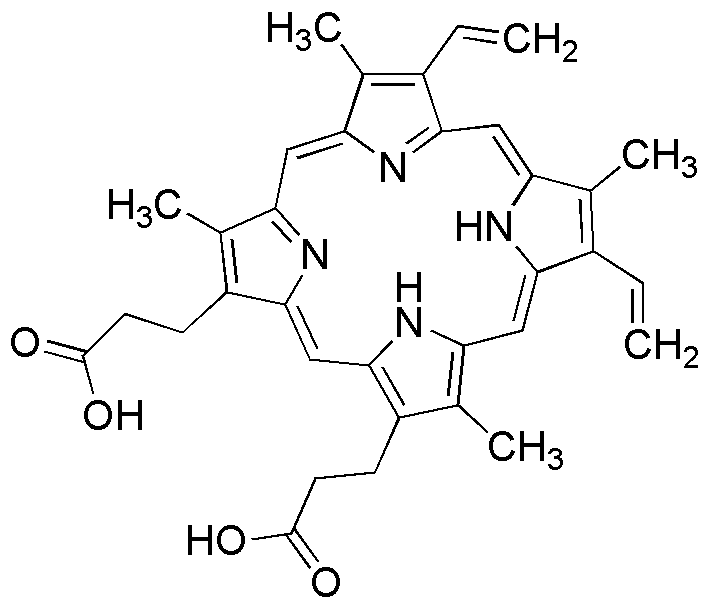Protoporphyrin IX is widely utilized in research focused on:
- Medical Diagnostics: It plays a crucial role in photodynamic therapy (PDT) for treating certain cancers. By absorbing light, it generates reactive oxygen species that can selectively destroy cancer cells, making it a valuable tool in oncology.
- Biochemical Research: This compound is essential in studying heme biosynthesis and its related disorders. Researchers use it to understand the mechanisms of diseases like porphyria, providing insights into metabolic pathways.
- Drug Development: Protoporphyrin IX is used as a photosensitizer in drug formulations. Its ability to target specific tissues enhances the efficacy of treatments while minimizing side effects, which is particularly beneficial in targeted therapies.
- Environmental Monitoring: It serves as a biomarker for assessing the health of aquatic ecosystems. By measuring its levels in organisms, scientists can gauge the impact of pollutants and environmental changes.
- Cosmetic Applications: Due to its antioxidant properties, it is being explored in skincare formulations. It can help protect skin cells from oxidative stress, contributing to anti-aging products.
Informations générales
Propriétés
Sécurité et réglementation
Applications
Protoporphyrin IX is widely utilized in research focused on:
- Medical Diagnostics: It plays a crucial role in photodynamic therapy (PDT) for treating certain cancers. By absorbing light, it generates reactive oxygen species that can selectively destroy cancer cells, making it a valuable tool in oncology.
- Biochemical Research: This compound is essential in studying heme biosynthesis and its related disorders. Researchers use it to understand the mechanisms of diseases like porphyria, providing insights into metabolic pathways.
- Drug Development: Protoporphyrin IX is used as a photosensitizer in drug formulations. Its ability to target specific tissues enhances the efficacy of treatments while minimizing side effects, which is particularly beneficial in targeted therapies.
- Environmental Monitoring: It serves as a biomarker for assessing the health of aquatic ecosystems. By measuring its levels in organisms, scientists can gauge the impact of pollutants and environmental changes.
- Cosmetic Applications: Due to its antioxidant properties, it is being explored in skincare formulations. It can help protect skin cells from oxidative stress, contributing to anti-aging products.
Documents
Fiches de données de sécurité (FDS)
La FDS fournit des informations de sécurité complètes sur la manipulation, le stockage et l’élimination du produit.
Spécifications du produit (PS)
Le PS fournit une description complète des propriétés du produit, notamment sa composition chimique, son état physique, sa pureté et les exigences de stockage. Il détaille également les plages de qualité acceptables et les applications prévues du produit.
Certificats d'analyse (COA)
Recherchez des certificats d'analyse (COA) en saisissant le numéro de lot du produit. Les numéros de lot et de lot se trouvent sur l'étiquette d'un produit, après les mots « Lot » ou « Lot de fabrication ».
Numéro de catalogue
Numéro de lot/série
Certificats d'origine (COO)
Ce certificat d'exploitation confirme le pays dans lequel le produit a été fabriqué, et détaille également les matériaux et composants utilisés et s'il est issu de sources naturelles, synthétiques ou autres sources spécifiques. Ce certificat peut être requis pour les douanes, le commerce et la conformité réglementaire.
Numéro de catalogue
Numéro de lot/série
Fiches de données de sécurité (FDS)
La FDS fournit des informations de sécurité complètes sur la manipulation, le stockage et l’élimination du produit.
DownloadSpécifications du produit (PS)
Le PS fournit une description complète des propriétés du produit, notamment sa composition chimique, son état physique, sa pureté et les exigences de stockage. Il détaille également les plages de qualité acceptables et les applications prévues du produit.
DownloadCertificats d'analyse (COA)
Recherchez des certificats d'analyse (COA) en saisissant le numéro de lot du produit. Les numéros de lot et de lot se trouvent sur l'étiquette d'un produit, après les mots « Lot » ou « Lot de fabrication ».
Numéro de catalogue
Numéro de lot/série
Certificats d'origine (COO)
Ce certificat d'exploitation confirme le pays dans lequel le produit a été fabriqué, et détaille également les matériaux et composants utilisés et s'il est issu de sources naturelles, synthétiques ou autres sources spécifiques. Ce certificat peut être requis pour les douanes, le commerce et la conformité réglementaire.


